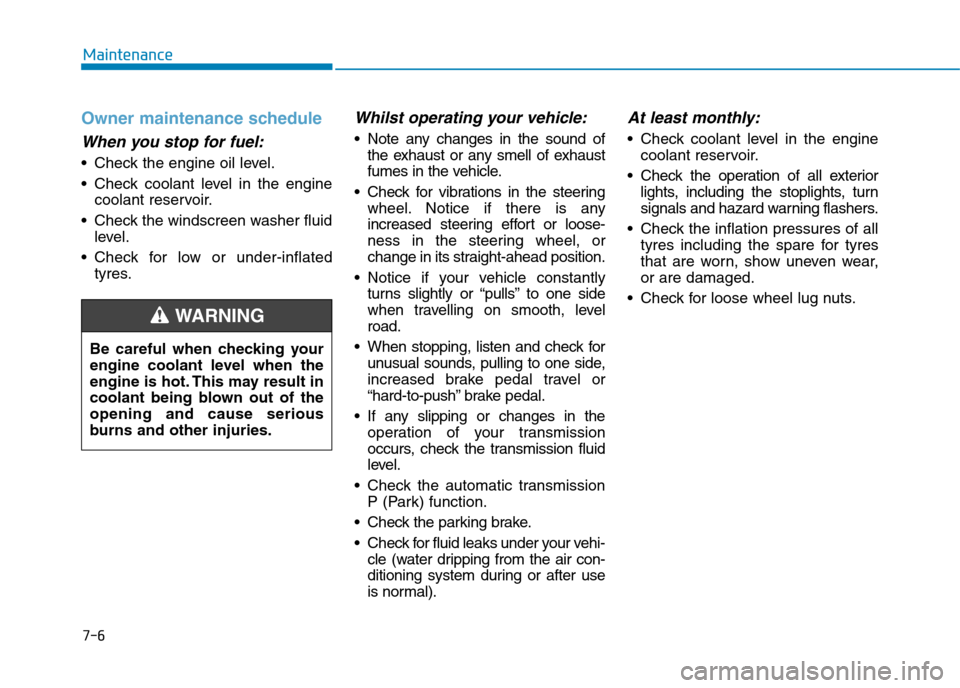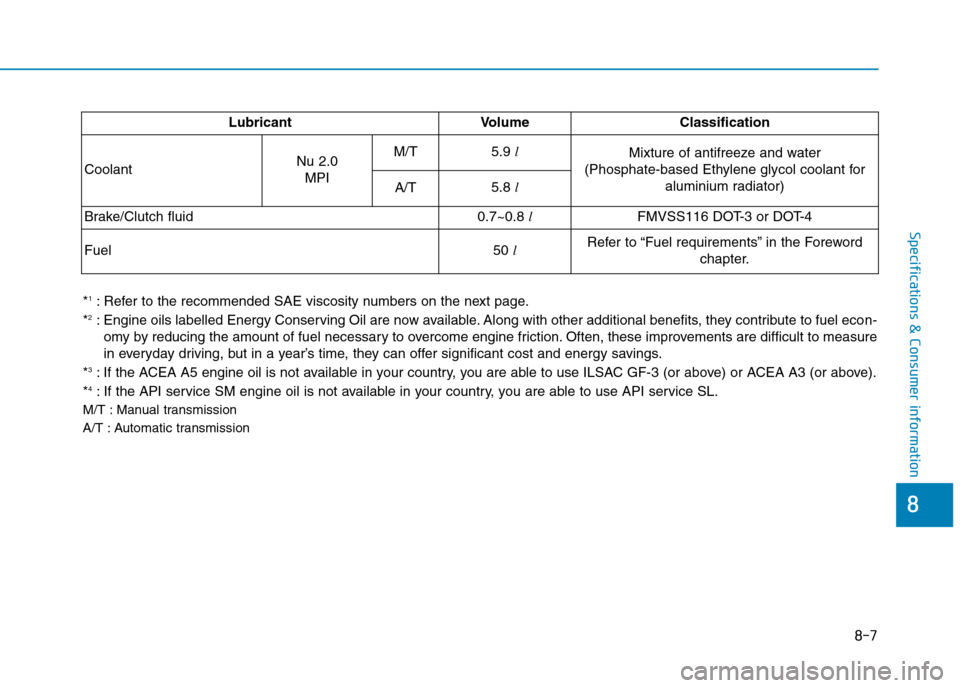Page 476 of 571

7-6
Maintenance
Owner maintenance schedule
When you stop for fuel:
•Check the engine oil level.
•Check coolant level in the engine
coolant reservoir.
•Check the windscreen washer fluid
level.
•Check for low or under-inflated
tyres.
Whilst operating your vehicle:
•Note any changes in the sound of
the exhaust or any smell of exhaust
fumes in the vehicle.
•Check for vibrations in the steering
wheel. Notice if there is any
increased steering effort or loose-
ness in the steering wheel, or
change in its straight-ahead position.
•Notice if your vehicle constantly
turns slightly or “pulls” to one side
when travelling on smooth, level
road.
•When stopping, listen and check for
unusual sounds, pulling to one side,
increased brake pedal travel or
“hard-to-push” brake pedal.
•If any slipping or changes in the
operation of your transmission
occurs, check the transmission fluid
level.
•Check the automatic transmission
P (Park) function.
•Check the parking brake.
•Check for fluid leaks under your vehi-
cle (water dripping from the air con-
ditioning system during or after use
is normal).
At least monthly:
•Check coolant level in the engine
coolant reservoir.
•Check the operation of all exterior
lights, including the stoplights, turn
signals and hazard warning flashers.
•Check the inflation pressures of all
tyres including the spare for tyres
that are worn, show uneven wear,
or are damaged.
•Check for loose wheel lug nuts.
Be careful when checking your
engine coolant level when the
engine is hot. This may result in
coolant being blown out of the
opening and cause serious
burns and other injuries.
WA R N I N G
Page 567 of 571
8-6
Specifications & Consumer information
RREECCOOMMMMEENNDDEEDD LLUUBBRRIICCAANNTTSS AANNDD CCAAPPAACCIITTIIEESS
To h e l p a c h i e v e p r o p e r e n g i n e a n d p o w e r t r a i n p e r f o r m a n c e a n d d u r a b i l i t y, u s e o n l y l u b r i c a n t s o f t h e p r o p e r q u a l i t y.
The correct lubricants also help promote engine efficiency that results in improved fuel economy.
These lubricants and fluids are recommended for use in your vehicle.
Lubricant Volume Classification
Engine oil *1*2(drain and refill)
RecommendsNu 2.0
MPI4.0l
API SM*4& ILSAC GF-4 (or above)
ACEA A5*3(or above)
Manual transmission fluidNu 2.0
MPI1.7~1.8
HK MTF 70W (SK)
SPIRAX S6 GHME 70W MTF (H.K.SHELL)
GS MTF HD 70W (GS CALTEX) (API GL-4, SAE 70W)
Automatic transmission fluidNu 2.0
MPI6.7 l
MICHANG ATF SP-IV,
SK ATF SP-IV,
NOCA ATF SP-IV,
HYUNDAI genuine ATF SP-IV
Page 568 of 571

8-7
8
Specifications & Consumer information
Lubricant Volume Classification
CoolantNu 2.0
MPI
M/T5.9 lMixture of antifreeze and water
(Phosphate-based Ethylene glycol coolant for
aluminium radiator)A/T5.8 l
Brake/Clutch fluid0.7~0.8 lFMVSS116 DOT-3 or DOT-4
Fuel50 lRefer to “Fuel requirements” in the Foreword
chapter.
*1:Refer to the recommended SAE viscosity numbers on the next page.
*2:Engine oils labelled Energy Conserving Oil are now available.Along with other additional benefits, they contribute to fuel econ-
omy by reducing the amount of fuel necessary to overcome engine friction. Often, these improvements are difficult to measure
in everyday driving, but in a year’s time, they can offer significant cost and energy savings.
*3:If the ACEA A5 engine oil is not available in your country, you are able to use ILSAC GF-3 (or above) or ACEA A3 (or above).
*4:If the API service SM engine oil is not available in your country, you are able to use API service SL.
M/T : Manual transmission
A/T : Automatic transmission